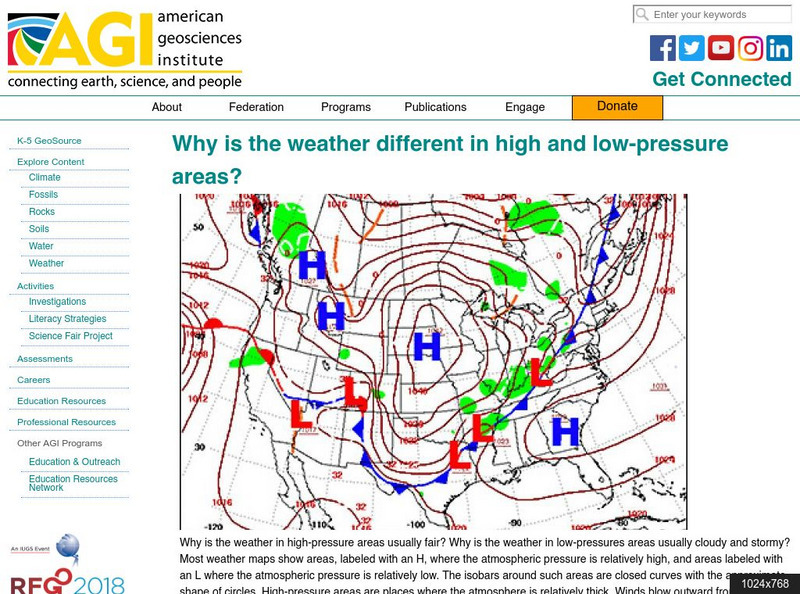Hi, what do you want to do?
Ducksters
Ducksters: Kids Science: Projects and Experiments
Kids learn by experimenting with science. Ideas for scientific projects on weather, sound, electricity, ecology.
Charlotte Mecklenburg Library
Story Place: What Will Bella Wear?
Help Bella decide what to wear when it is raining, snowing, and hot and sunny.
Other
Campbell Scientific: Automatic Weather Stations
Provides information on a variety of weather station types.
TES Global
Blendspace: Pbl: Climate/weather
An eighteen-part learning module with links to images, videos, and websites about climate and weather.
University Corporation for Atmospheric Research
Ucar: Unidata: Conventional Weather Reports
This resource talks about how the stations report their information. Several examples of how different universities compile the information are provided.
ClassFlow
Class Flow: Tornado Experiment
[Free Registration/Login Required] This flipchart has a full lesson plan (with standards and adaptations) about Tornadoes. An experiment is included with materials description, pictures, and every step. It is intended to be easy to read...
ClassFlow
Class Flow: Tornados in the Us
[Free Registration/Login Required] Overview: In this lesson, students will learn the basics about how tornadoes are formed, and when and where they are most likely to occur. They will learn that the United States is the country most...
Other
National Pollutant Inventory: Background Information
This site focuses on water and air pollution in Australia, with a brief mention of sea breezes.
CK-12 Foundation
Ck 12: Earth Science: Weather Versus Climate
[Free Registration/Login may be required to access all resource tools.] Compares and contrasts weather and climate.
ClassFlow
Class Flow: Water Cycle
[Free Registration/Login Required] This is a science flipchart that reviews the stages of the water cycle and also ways in which the water cycle affects weather such as hurricanes and tornadoes.
ClassFlow
Class Flow: Weather
[Free Registration/Login Required] This flipchart discusses the weather, sun, earth, day, night, and rotation.
ClassFlow
Class Flow: Weather
[Free Registration/Login Required] This weather unit discusses all types of weather for a kindergarten science unit. Students learn new science vocabulary, learn about weather tools, discuss weather pictures, play online learning games,...
ClassFlow
Class Flow: Weather and Seasons
[Free Registration/Login Required] This flipchart discusses the weather and seasons and explains the appropriate clothing to wear in the respective seasons.
ClassFlow
Class Flow: Weather Maps
[Free Registration/Login Required] This flipchart defines and gives examples of various weather symbols and descriptive words concerning weather patterns. It explains the uses of weather maps and how scientists use these to predict the...
ClassFlow
Class Flow: Weather Study for Kindergarten
[Free Registration/Login Required] This flipchart is a science unit on weather. Students use the board to answer questions, move objects, and chart observations. An Activote is included for summative assessment.
American Geosciences Institute
American Geosciences Institute: How Can We Measure the Wind?
Find out how scientists measure wind to help understand the weather.
American Geosciences Institute
American Geosciences Institute: What Is Atmospheric Pressure?
See how atmospheric pressure affects air masses, which in turn affects the weather on Earth.
American Geosciences Institute
American Geosciences Institute: Weather in High and Low Pressure Areas
Find out why weather in high pressure areas is fair, and weather in low pressure areas is cloudy and stormy.
ClassFlow
Class Flow: Frontal Depressions
[Free Registration/Login Required] A flipchart showing the separate stages of a frontal depression with reference to the weather charts that plot them, diagrams of the air masses that are moved around in them, and also of the cloud...
ClassFlow
Class Flow: I Site: Wild Weather
[Free Registration/Login Required] This flipchart from New Zealand looks at extreme weather conditions from tornadoes to floods, their causes and effects.
ClassFlow
Class Flow: Australia Revealed Geography and Weather
[Free Registration/Login Required] Using video and Activote assessment questions, students will learn basic facts about the geography and weather of Australia. This is part of a series of eight flipcharts.
ClassFlow
Class Flow: Calendar
[Free Registration/Login Required] This flipchart helps students with calendar concepts, such as, the days of the week, the date, weather, and the temperature.
ClassFlow
Class Flow: Climate Intro
[Free Registration/Login Required] This flipchart is a short, basic introduction to climate. It includes solar radiation and the electromagnetic spectrum.
ClassFlow
Class Flow: Clouds
[Free Registration/Login Required] This flipchart shows and defines different types of clouds.




























